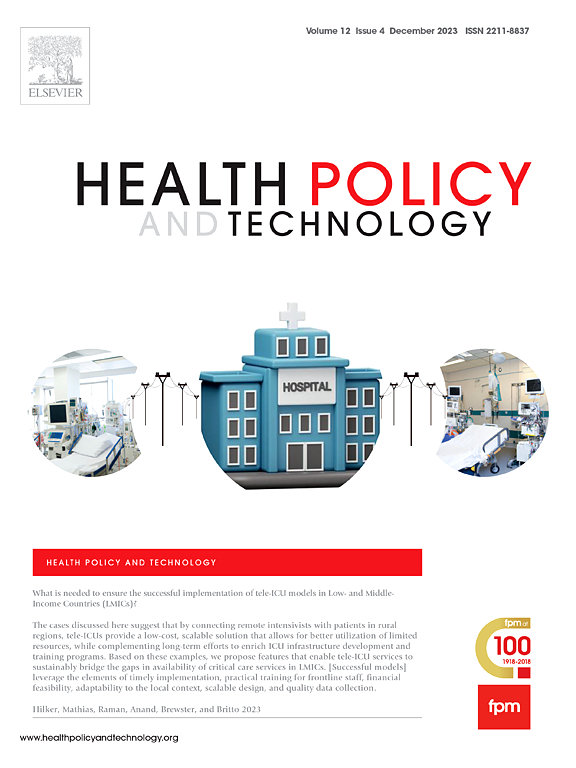Societal preferences for prioritizing patients suffering from breast cancer, deafness, or knee arthrosis for scarce surgical capacity
IF 3.7
3区 医学
Q1 HEALTH POLICY & SERVICES
引用次数: 0
Abstract
Objective
Constraints on surgical capacity due to budgetary and workforce shortages necessitate prioritization. Lessons learned from the COVID-19 pandemic emphasize the societal debate around these decisions and stress the need to align decisions with societal preferences. This study examines societal preferences for prioritizing patients with three conditions—breast cancer, deafness, or knee arthrosis—for scarce surgical capacity.
Methods
We conducted a labelled discrete choice experiment among 1,046 members of the Dutch public. Respondents completed 14 choice tasks in which they prioritized patients for surgery, based on their condition, age, health-related quality of life (HRQOL) before and after surgery, and waiting time until surgery. We used conditional logit, multinomial logit, and latent class models to examine (heterogeneity in) respondents’ preferences.
Results
Respondents were more likely to prioritize patients suffering from breast cancer over those with knee arthrosis or deafness. They also prioritized patients with lower levels of HRQOL before surgery, larger surgery-related increases in HRQOL, and longer waiting times. They were less likely to prioritize patients who were older, except in the case of deafness. Observed preference heterogeneity largely resulted from differences in preference strength, rather than direction.
Conclusions
Our results provide insight into societal preferences for prioritizing patients with different conditions for surgery. This insight aids in understanding public outcry that may follow deviating decisions. Aligning prioritization decisions with societal preferences may increase the legitimacy of such decisions. Further research may examine the relevance of these preferences for physicians and their willingness to be guided by evidence on societal preferences.
社会倾向于优先考虑患有乳腺癌、耳聋或膝关节疾病的患者,因为他们缺乏手术能力
目的由于预算和劳动力短缺,手术能力受到限制,需要优先考虑。从2019冠状病毒病大流行中吸取的教训强调了围绕这些决定的社会辩论,并强调需要使决策与社会偏好保持一致。这项研究考察了社会对三种情况(乳腺癌、耳聋或膝关节疾病)患者优先考虑手术能力不足的偏好。方法我们对1046名荷兰公众进行了标记离散选择实验。受访者完成了14项选择任务,根据患者的病情、年龄、术前和术后健康相关生活质量(HRQOL)以及等待手术的时间,对患者进行手术排序。我们使用条件logit、多项logit和潜在类别模型来检验受访者偏好的异质性。结果受访者更倾向于优先考虑患有乳腺癌的患者,而不是患有膝关节疾病或耳聋的患者。他们还优先考虑术前HRQOL水平较低、手术相关HRQOL增加较大、等待时间较长的患者。除了耳聋患者外,他们不太可能优先考虑年龄较大的患者。观察到的偏好异质性主要来自偏好强度的差异,而不是偏好方向的差异。结论我们的研究结果揭示了社会对不同情况患者优先选择手术的偏好。这种洞见有助于理解偏离决策后可能出现的公众抗议。将优先级决定与社会偏好相一致可能会增加此类决定的合法性。进一步的研究可能会检查医生的这些偏好的相关性,以及他们是否愿意接受社会偏好证据的指导。
本文章由计算机程序翻译,如有差异,请以英文原文为准。
求助全文
约1分钟内获得全文
求助全文
来源期刊

Health Policy and Technology
Medicine-Health Policy
CiteScore
9.20
自引率
3.30%
发文量
78
审稿时长
88 days
期刊介绍:
Health Policy and Technology (HPT), is the official journal of the Fellowship of Postgraduate Medicine (FPM), a cross-disciplinary journal, which focuses on past, present and future health policy and the role of technology in clinical and non-clinical national and international health environments.
HPT provides a further excellent way for the FPM to continue to make important national and international contributions to development of policy and practice within medicine and related disciplines. The aim of HPT is to publish relevant, timely and accessible articles and commentaries to support policy-makers, health professionals, health technology providers, patient groups and academia interested in health policy and technology.
Topics covered by HPT will include:
- Health technology, including drug discovery, diagnostics, medicines, devices, therapeutic delivery and eHealth systems
- Cross-national comparisons on health policy using evidence-based approaches
- National studies on health policy to determine the outcomes of technology-driven initiatives
- Cross-border eHealth including health tourism
- The digital divide in mobility, access and affordability of healthcare
- Health technology assessment (HTA) methods and tools for evaluating the effectiveness of clinical and non-clinical health technologies
- Health and eHealth indicators and benchmarks (measure/metrics) for understanding the adoption and diffusion of health technologies
- Health and eHealth models and frameworks to support policy-makers and other stakeholders in decision-making
- Stakeholder engagement with health technologies (clinical and patient/citizen buy-in)
- Regulation and health economics
 求助内容:
求助内容: 应助结果提醒方式:
应助结果提醒方式:


